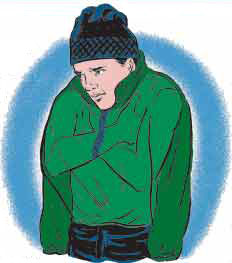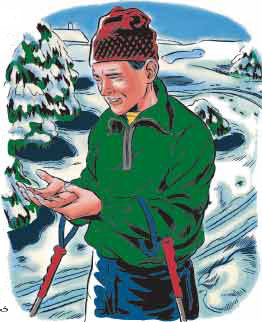How to avoid frostbite
 “Don’t go far,” Frank Simon’s mom called as Frank and his three friends set out to ski the backcountry from a lodge at Paradise Inn, Wash. It was a sunny day, but the temperature on the lower slopes of Mount Rainier wouldn’t climb above freezing.
“Don’t go far,” Frank Simon’s mom called as Frank and his three friends set out to ski the backcountry from a lodge at Paradise Inn, Wash. It was a sunny day, but the temperature on the lower slopes of Mount Rainier wouldn’t climb above freezing.
The boys’ route through the woods and up a gentle slope didn’t seem long to Frank. But Bill Wright, his best friend, was wearing thin gloves instead of thick mittens. After an hour or so Bill said in a frightened voice, “I can’t feel my fingers!”
Frank looked at them. They were white and extremely cold to his touch. Frank told Bill to put his hands in his own armpits, against his skin, until the fingers were rewarmed.
Bill did and was able to ski back to the lodge. He was lucky. He’d suffered no permanent damage.
COLD BITES
Frostbite is tissue damage caused by freezing. It comes in three types: Frostnip, superficial frostbite and deep frostbite.
Frostnip is not true frostbite, just supercold skin. It looks pale and feels cold. Sometimes frostnipped skin apprears as a patch of white on your cheeks or nose. As soon as you see this, cover the cold spot with your warm hands.
If your fingers or toes are affected, do as Bill did. Stick them inside your clothing, next to your wam skin, until they rewarm and appear normal again.
Superficial frostbite is the term for cold-damaged tissue that hasn’t frozen solid. When you push carefully on the cold skin, it’s still pretty soft. It looks like frostnip, but when you rewarm it (the same way you rewarm frostnip), fluid-filled blisters develop.
Don’t pop these blisters. Cover them with a clean dressing and be careful to keep the skin from freezing again. This person needs to see a doctor.
Deep frostbite occurs when tissue has frozen solid. The skin is no longer soft. It feels like ice. Unlike superficial frostbite, you don’t want to rewarm deep frostbite. It can be very painful, and a doctor should oversee it. Insulate the area to keep it from thawing or freezing even more, and get the person to a doctor as soon as possible.
PREVENTION
You can protect yourself from frostnip and frostbite by:
- Wearing mittens. They hold more heat than do gloves.
- Being especially careful to wear winter boots that fit. Don’t cram extra socks into summer boots and think that will keep your feet warm. If your feet are too tightly smushed into boots, warm blood can’t get to your toes.
- Drinking plenty of water and snacking often. Your body turns water and food into fuel to warm you.
 REWARMING NO-NOS
REWARMING NO-NOS
Do not rub frostbite to rewarm it. Rubbing causes more damage. Do not hold frostbitten skin near a fire or another source of high heat. High heat causes more damage, too.
yeah! frostbite is and can be pretty bad
Oh, and frostbite is not so good if you get it so stay warm.
P.s.Hi
It is very interesting that the cold air could cause so much trouble!
Wow this really helps me with my next camp trip
since its gonna be like -20 degrees
When I was at a klondike derby a kid from another troop had sneakers on and bad equipment he was showing signs of hypothermia so my troop leader had to take him to head quaters and he was in bad shape from then on sneakers have been banned everyone most wear boots it pays to stay warm hypothermia can happen to anyone
this may become useful. thanx boyslife
AWesome stuff
thanks for the info BoysLife Mag.
Awsome. If your fingers get cold form a fist in your glove and remember to keep on moving (I find the most useful thing). Don’t go into the warming house unless you’re about to die. Otherwise you won’t learn how to deal with the pain and cold.
cool!